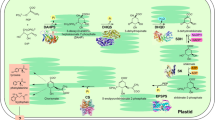Abstract
The long chain fatty acids incorporated into plant lipids are derived from the iterative addition of C2 units which is provided by malonyl-CoA to an acyl-CoA after interactions with 3-ketoacyl-CoA synthase (KCS), found in several plants. This study provides functional characterization of three 3 ketoacyl CoA synthase like proteins in Vitis vinifera (one) and Oryza brachyantha (two proteins). Sequence analysis reveals that protein of Oryza brachyantha shows 96% similarity to a hypothetical protein in Sorghum bicolor; total 11 homologs were predicted in Sorghum bicolor. Conserved domain prediction confirm the presence of FAE1/Type III polyketide synthase-like protein, Thiolase-like, subgroup; Thiolase-like and 3-Oxoacyl-ACP synthase III, C-terminal and chalcone synthase like domain but very long chain 3-keto acyl CoA domain is absent. All three proteins were found to have Chalcone and stilbene synthases C terminal domain which is similar to domain of thiolase and β keto acyl synthase. Its N terminal domain is absent in J3M9Z7 protein of Oryza brachyantha and F6HH63 protein of Vitis vinifera. Differences in N-terminal domain is responsible for distinguish activity. The J3MF16 protein of Oryza brachyantha contains N terminal domain and C terminal domain and characterized using annotation of these domains. Domains Gcs (streptomyces coelicolor) and Chalcone-stilbene synthases (KAS) in 2-pyrone synthase (Gerbera hybrid) and chalcone synthase 2 (Medicago sativa) were found to be present in three proteins. This similarity points toward anthocyanin biosynthetic process. Similarity to chalcone synthase 2 reveals its possible role in Naringenine and Chalcone synthase like activity. In 3 keto acyl CoA synthase of Oryza brachyantha. Active site residues C-240, H-407, N-447 are present in J3MF16 protein that are common in these three protein at different positions. Structural variations among dimer interface, product binding site, malonyl-CoA binding sites, were predicted in localized combination of conserved residues.
Similar content being viewed by others
Abbreviations
- ACP:
-
Acyl carrier protein
- CHS:
-
Chalcone synthase
- FA:
-
Fatty acid
- KCS:
-
3 keto acyl CoA Synthase
- Gcs:
-
Germicidin synthase
- PS:
-
Pyrone synthase
- PKS:
-
polyketide synthase
- J3M9Z7 ORYBR & J3MFI6 ORYBR:
-
3 keto acyl CoA Synthase like protein in Oryza brachyantha
- F6HH63 VITVI:
-
3 keto acyl CoA Synthase in Vitis vinifera
- VLCFA:
-
Very long chain fatty acids
References
Arnold, K., Bordoli, L., Kopp, J., Schwede, T. 2006. The SWISS-MODEL Workspace: A web-based environment for protein structure homology modeling. Bioinformatics 22, 195–201.
Benkert, P., Biasini, M., Schwede, T. 2011. Toward the estimation of the absolute quality of individual protein structure models. Bioinformatics 27(3), 343–350.
Chothia, C., Lesk, A.M. 1986. The relation between the divergence of sequence and structure in proteins. EMBO J. 5, 823–826.
Combet, C., Jambon, M., Deléage, G., Geourjon, C. 2002. Geno3D: automatic comparative molecular modelling of protein. Bioinformatics 18(1), 213–214.
Chen, J.F., Huang, Q.F., Gao, D.Y., Wang, J.Y., Lang, Y.S., Liu, T.Y., Li, B., Bai, Z.T., Goicoechea, J.L., Liang, C.Z., Chen, C.B., Zhang, W.L., Sun, S.H., Liao, Y., Zhang, X.M., Yang, L., Song, C.L., Wang, M.J., Shi, J.F., Liu, G., Liu, J.J., Zhou, H.L., Zhou, W.L., Yu, Q.L., An, N., Chen, Y., Cai, Q.L., Wang, B., Liu, B.H., Min, J.M., Huang, Y., Wu, H.L., Li, Z.Y., Zhang Y., Yin, Y., Song, W.Q., Jiang, J.M., Jackson, S.A., Wing, R.A., Wang, J., Chen, M.S. 2013. Whole-genome sequencing of Oryza brachyantha reveals mechanisms underlying Oryza genome evolution Nature Communication 1595.
Lee, S.B., Jung, S.J., Go, Y.S., Kim, H.U., Kim, J.K., Cho, H.J., Park, O.K., Suh, M.C. 2009. Two Arabidopsis 3-ketoacyl CoA synthase genes, KCS20 and KCS2/DAISY, are functionally redundant in cuticular wax and root suberin biosynthesis, but differentially controlled by osmotic stress. Plant J. 60(3), 462–475.
Mizuguchi, K., Deane, C.M., Blundell, T.L., Overington, J.P. 1998. HOMSTRAD: a database of protein structure alignments for homologous families. Protein Science 7, 2469–2471.
Marchler-Bauer, A., Zheng, C., Chitsaz, F., Derbyshire, M.K., Geer, L.Y., et al. 2013. CDD: conserved domains and protein three-dimensional structure. Nucleic Acids Research 41, D384–D352.
Palo, R.T. 1984. Distribution of birch (Betula Spp), willow (Salix Spp), and poplar (Populus Spp) Secondary metabolites and their potential role as chemical defence against herbivores. J. Chem. Ecol. 10, 499–520.
Pettersen, E.F., Goddard, T.D., Huang, C.C., Couch, G.S., Greenblatt, D.M., Meng, E.C., Ferrin, T.E. 2004. UCSF Chimera-a visualization system for exploratory research and analysis. J. Comput. Chem. 25(13), 1605–1612.
Quevillon, E., Silventoinen, V., Pillai, S., Harte, N., Mulder, N., Apweiler, R., Lopez R. 2005 InterProScan: protein domains identifier, Nucleic Acids Research, 332.
R. Thamos Palo: Distribution of birch (Betula SPP.), willow (Salix SPP.), and poplar (Populus SPP.) secondary metabolites and their potential role as chemical defense against herbivores. Journal of Chemical Ecology 10(3), 499–520.
Robin, D. Mellway, Lan, T. Tran, Michael, B. Prouse 2009. The Wound-, Pathogen-, and Ultraviolet BRe-sponsive MYB134 Gene Encodes an R2R3 MYB Transcription Factor That Regulates Proanthocyanidin Synthesis in Poplar1. Plant Physiology, American Society of Plant Biologists 150, 924–941.
Schwede, T., Kopp, J., Guex, N., Peitsch, M.C. 2003. SWISS-MODEL: an automated protein homologymodeling server. Nucleic Acids Research 31,3381–3385.
Shi, J., Blundell, T.L., Mizuguchi, K. 2001. Sequence-structure homology recognition using environment specific substitution tables and structure-dependent gap penalties. J Mol Biol. 310(1), 243–57.
Smith, T.F., Waterman, M.S. 1981. Identification of common molecular subsequences. J. Molecular Biology 147, 195–197.
Author information
Authors and Affiliations
Corresponding author
Rights and permissions
About this article
Cite this article
Sagar, M., Pandey, N., Qamar, N. et al. Domain analysis of 3 Keto Acyl-CoA synthase for structural variations in Vitis vinifera and Oryza brachyantha using comparative modelling. Interdiscip Sci Comput Life Sci 7, 7–20 (2015). https://doi.org/10.1007/s12539-013-0017-8
Received:
Revised:
Accepted:
Published:
Issue Date:
DOI: https://doi.org/10.1007/s12539-013-0017-8




